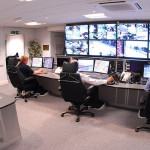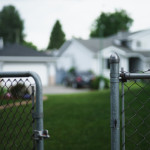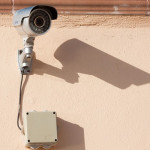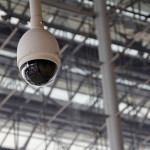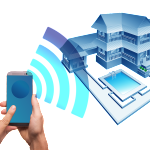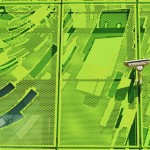Artificial Intelligence For Video Surveillance
There’s no denying that video surveillance technology has come a long way over the years. From grainy videos in its early stages to the quality software and clarity today, video surveillance continues to make great strides and advancements.
History
The goal of security cameras and surveillance systems is to capture, detect, and deter any unlawful behavior in and around homes, businesses, and public areas. Before, installing a security camera system was a costly and laborious job, involving lots of wires and cables running throughout the building. As technology progressed, security cameras became more accessible and affordable, allowing more users the opportunity to invest in their security. Now there are numerous DIY solutions that make it easy for homeowners to install and set up on their own security systems.
For businesses, implementing a team of people to actively monitor security cameras at all times was once the only option. Now, much of the monitoring aspect of security and surveillance systems can be automated. Rather than having the mundane task of watching numerous monitors, security cameras now have the ability to detect any suspicious or abnormal behaviors and will alert a security officer as necessary.
While we have seen the security industry flourish over the years, this is just the tip of the iceberg. Our technology will continue to advance and amaze us in ways we never thought possible.
Artificial Intelligence
Artificial intelligence (AI) in video surveillance enables the “smart” features we now see with security cameras. In general, security cameras enable us to monitor situations in real-time or go back to review previous footage. With the integration of AI technology, not only can we monitor in real-time, but potential issues can be identified before they become real problems.
With the emergence of video analytics, footage can be analyzed immediately to identify any abnormal activity or threats early on. This technology helps the software ‘learn’ what is normal in order to identify unusual behavior and is meant to make up for human error, rather than replace human monitoring all together.
While it was always a goal to integrate AI and video surveillance, the technology, from a hardware standpoint, was not ready. One of the issues that needed to be addressed was decreasing the power demand to a level low enough that would allow the technology to be embedded into the cameras.
As more cameras emerge with new AI technologies and processes, we will begin to see more advanced features including crowd density monitoring, facial recognition, stereoscopic vision, and behavior analysis.
Behavior analysis in particular is what a lot of tech companies are focusing on. By implementing a technology that can identify and recognize precursor patterns associated with crimes and other bad behavior, we may be able to greatly improve public safety and security.
A great example comes from the West Japan Railway, where it was found that 60% of people hit by trains in Japan were intoxicated. They have now installed security cameras that can automatically search for and detect signs of intoxication. Sleeping on benches, stumbling, falling, or standing motionless for long periods of time are behaviors that are recognized by the AI system. Human attendees are then notified and sent to check on the person.
Of course, a conversation about video surveillance always includes concerns about privacy. No one wants to feel like they are constantly being monitored, but developers insist that these systems know when to stop collecting information and monitoring. As these technologies continue to develop, you may soon be able to “teach” your system when to record and in which situations recording should halt.
Although it is still in its early stages, AI technology and video surveillance is heading in a positive and exciting direction. Mass adoption may still be a ways to go, but it’s great to see AI being applied in a new setting.
What are your thoughts on artificial intelligence and the video surveillance industry? Share with us on Facebook, Google+, Twitter, LinkedIn, and Pinterest. Browse our selection of security cameras and equipment online at SecurityCamExpert.com. To learn more about our installation services or to request a free quote, please call 888-203-6294.
Protect Your Vacant Property
Think an empty building doesn’t need maintenance or security? Think again. Unoccupied buildings tend to be more susceptible to damage and criminal activity than those filled with expensive equipment. If your property will be vacant, whether long or short term, you should secure it as soon as possible.
Main Risks For Empty Buildings
- Weather
We all know that weather can cause significant damage relatively quickly, especially for buildings in areas known for inclement weather. Damage to the exterior, including the roof and windows, can also make its way inside to cause further problems.
- Thieves
If you leave equipment or anything of value in an unsecured building, you run a high risk of theft. Even if you’ve emptied the property, thieves may still enter and steal valuable construction materials (ex. copper pines or wires).
- Vandals
Even though you may have cleared out your property, you are still at risk for vandalism. Vandals may trash your property by leaving waste, breaking things, and covering walls in graffiti.
- Trespassing
This covers a number of threats, which include squatting and illicit activities.
How To Secure Your Vacant Property
- Secure Entrances
Before vacating a property, be sure that all windows and doors are properly closed and locked. Look for gaps or damage to the frames that may allow wind, rain, or intruders to get in.
If you plan on leaving for an extended period of time, you should consider investing in stronger methods of securing doors and windows. While traditional wood boarding may be cost-effective, these have also added to the blaze of an arson attack. Investing in a metal alternative may be a better choice. You may also want to consider steel security doors which make it impossible to access your building without special equipment.
- Maintain Exteriors
Any loose objects can be stolen, used to gain entry, or used as a weapon. For example, bins, palettes and spare construction materials can quickly turn into projectiles in the wrong hands, or can be picked up by high winds in a storm. Be sure to store large objects indoors or out of sight.
Landscaping may be an afterthought, but can make a difference. You should keep pathways clear of debris, such as snow and ice in the winter, and trim grass and hedges to deter vermin from inhabiting your yard. Landscaping also makes it appear that the premise is occupied, making it less of a target.
- Check The Alarms
A security alarm is a necessity. A security alarm system can deter intruders, and, if linked to the local police, can elicit immediate response to any incidents. If you vacate your building, be sure to check your system regularly to ensure that it is functioning properly. If your system is managed by a third party, be sure to inform them of your absence.
Because a fire, whether intentional or accidental, is always possible, you should also maintain your fire alarm and sprinkler system. Be sure that pipes and sensors remain functional.
- Increase Passive Security
While dummy cameras can be a reasonable deterrent for those on a budget, operational security cameras may be a better investment. If you plan on leaving your property vacant for a longer period, you may want a real security camera to record any trespassers or criminal activity that occurs while you’re gone.
It may behoove you to make your property physically harder to access, especially if you have open spaces. Fencing and gates with proper locks and concrete barriers are effective ways to keep intruders out.
- Hire Active Security
If you will be storing valuable equipment and materials on site during your absence, you may want to hire professional guard control or even guard dogs and handlers. You can schedule the guard to check on your building at random times to keep trespassers away and to report any unusual activity.
If a building is scheduled for future renovation or demolition, registering your building for a guardianship scheme could be a more cost-effective solution. While you won’t be able to freely access your building when the guards are there, but it will safeguard against trespassers and squatters.
How do you protect your vacant property? Share your tips on Facebook, Google+, Twitter, LinkedIn, and Pinterest.
Find quality security cameras and CCTV surveillance systems when you shop at SecurityCamExpert.com! Visit us online or call 888-203-6294 to learn more about our services, including installation and support.
Perimeter Security
Whether you are securing your home or business, perimeter security is often your first line of defense. Aside from the exterior of the structure, perimeter security creates boundaries to keep intruders out. If you are considering perimeter security, there are numerous options available to you – here’s what you need to know.
Locks
Locks are very important to perimeter security. If you have nothing protecting your property beyond the walls of your home or building, you will need to invest in strong, sturdy locks. The most common breach would be forced entry, which simply destroys the lock to gain access. To safeguard against this, you want to choose locks that make use of hardened metal alloys that are as thick as possible.
Cutting attacks are common if you are using padlocks on your gates. Aside from the shackles of the locks, the hasp or chain being secured by the padlock may also be targeted for cutting. If these are weaker than the lock, the strength of the lock will not matter.
When it comes to covert entry, bump keys are more of a concern than lock picking, as the latter wastes time and effort. The internal complexity for locks will help increase perimeter security and prevent unauthorized key duplication.
Walls
Unlike a fence, walls provide more privacy as they better obstruct visibility. Higher walls mean lower visibility and a greater obstacle to gain entry. The downside is that the decreased visibility affects both sides, meaning that while outsiders may not be able to see in, you may not be able to see anyone approaching the property.
Luckily, the visibility concerns for high walls can be resolved with the use of security cameras or other forms of documentation (such as security guards). Documentation is a key consideration (which will be discussed further), but it is not always feasible for some.
In the end, it all comes down to the intention of your perimeter security. With a wall, you get more privacy and a sturdy barrier which allows you to put more focus on securing the gate.
Fencing
Fences offer extreme flexibility in that the price, look, and functionality have the most range. You can adjust the visibility by choosing different designs and even growing ivy or other plants around it. In extreme cases, most common fences may be easier to electrify, depending on the material of the fence.
Unless you have concerns about automotive ramming threats, the fact that a fence is weaker than a wall may be a minor detail. However, fences may be compromised at certain points, whether from vandalism or wear, thus creating entryways which defeat the purpose of perimeter security measures. Even if the openings are not wide enough for humans, you run the risk of animal infestation or pet escape.
Wood fences and chain link fences are often the most common types, and usually signify a boundary that others should not cross, or simply denote a property line. Fences alone are rarely high security, but with electrification or barbed wire, they can be somewhat intimidating.
Gates
A gate is the moving section on a gate or wall that allows entry and exit through perimeter security. Because this is usually the only point of entry and exit around the perimeter of a building, the gate will need a locking mechanism.
If you are planning on taking vehicles past the perimeter security, you may want to use a motorized track and electronic lock. For gates with less traffic or only foot traffic, choose a high-security padlock. There may also be a gate setup that allows you to use a deadbolt and or/keyed handle/knob.
For effective perimeter security, a keyed handle/knob may not be the best choice. A deadbolt provides more security, however, the strength of the deadbolt must be considered. But keep in mind, if the lock is too strong, the material of the gate may be attacked, or intruders may simply climb over.
Lighting
Perimeter security systems should always consider lighting, and one of the first things to assess is shadows. Trees, pillars and other tall obstructions will create dark shadows for criminals to lurk. With proper light, you afford yourself the ability to see criminals approaching or attempting to bypass your perimeter security.
Motion sensor lights are effective in that they focus attention and are often the choice for many residential buildings without security guards. For residents, a light turning on suddenly will often alert them of unexpected movement around the house. For those properties with high walls, or an obstructing fence, the abrupt light hopefully catches the attention of neighbors or pedestrians.
Despite drawing attention, your security depends on whether or not bystanders or neighbors intervene. Everyone has an interest in preventing crime, but if someone is unaware of the threats or the victim, people may do nothing to avoid confrontation. It may behoove you and your property to get to know your neighbors and keep a lookout for each other.
Alerts & Notification
Some people may struggle with the decision of investing in a dog or an alarm system. While getting both is definitely an option, the decision will likely come down to your ability to take care of an animal. When it comes to alarms, you will want one that offers monitored security so that authorities can be notified in case of emergency.
However, these notifications are only effective if response times are within the average time it takes to commit a break-in. If not, alerts and notifications are rather useless. A loud alarm may help to alert anyone who is around to the crime that is taking place.
If you’re looking for more discreet notifications, a smart lock with access notifications might be the solution. This allows you to know when a lock has been opened, and can be extremely helpful if you suspect any internal threats.
Documentation
Most perimeter security systems rely on security cameras. They are largely accessible and are great for capturing evidence of threats and criminal acts.
Before installing security cameras, you should know what is allowed and what is not. You must abide by the law when it comes to documentation efforts otherwise your footage will be useless and may even get you in hot water.
When choosing cameras, you should keep your security intentions in mind. If you need footage that will hold up in court, you will need the right kind of camera to record quality video in that environment. You will need to consider glare from the daylight and possibly night vision. Also, you need to consider placement as you may need multiple cameras to adequately cover your perimeter. If you have more questions regarding security cameras systems and installation, feel free to call us at 888-203-6294.
Natural Barriers
A positive natural barrier is something that offers another level of security to your property. This can be anything from the proximity to a police station to a single, long road leading to your home.
Consequently, there are also natural barriers that prevent you from taking full advantage of your possible perimeter security system. For example, a treeline on the side of your property may offer a natural border, however, it may also help intruders cover their approach. Also, motion sensor cameras and lights placed in heavy foot traffic areas may produce lots of false alarms, becoming more of a nuisance than an effective security measure.
Your best bet is to identify what works for you and what does not in terms of security. You shouldn’t invest in a method of perimeter security just to use it. Focus on the positive barriers and try to compensate for any negative barriers you cannot change.
Aesthetics
The consideration for aesthetics is to find a balance between it and your perimeter security. Rather than choosing to make the property look good and then incorporate security, you should be trying to make the security you need look good.
If you are adding to your landscape or home, you should always consider how it will affect your perimeter security. It is best to opt for something with a neutral or positive effect, not something that will be a detriment.
Access Control
Who has access to your property is a very important part of making your perimeter security work to your benefit. Key control is a good starting point (numeric codes, RFID remotes, physical keys, etc.). With codes and biometric locks, your access control management software may make it quite simple to know who is entering the property and when. If any issues arise, it is easy to simply revoke privileges.
Those who have access should be trusted individuals. You should be sure that they will not take advantage of your property and will take the necessary precautions to protect their key from being stolen or misused.
Key control for physical keys can be taken care of by investing in locks with patented keyways. This will improve your protection against most forms of covert entry, but mostly it will prevent unauthorized key duplication.
Which perimeter security methods do you find most effective? Share with us on Facebook, Google+, Twitter, LinkedIn, and Pinterest.
Visit SecurityCamExpert.com to browse our selection of quality CCTV surveillance systems and learn more about our Installation and support services.
The Progression of Video Surveillance Technologies
Over the years, video surveillance has made great improvements in regards to design, features, functionality and application. As our technologies continue to evolve, the surveillance industry is bound to grow and expand even further.
In 1996, Axis Communications introduced the first IP Camera. This was originally used for monitoring the sea for oil spills, saving their customers from having to take two flights a day. Decades later, digital cameras are now the norm, from entertainment to security purposes.
When it comes to security, because we are very visual and use our eyes more than any other senses, we tend to prefer video. This is why we see CCTV surveillance cameras nearly everywhere these days. But how can we improve it?
Video surveillance can be valuable to businesses, however, monitoring the live feed 24/7 is not very realistic. Other detection tools, such as perimeter breach or motion detection, in conjunction with an alarm or alert system helps to improve security. But, as with most things, it has its flaws. These can include problems with detecting the breach, a bad judgment call in regards to what is seen, how long the feed is monitored and the length of backtracking.
Video analytics is more prevalent these days and makes efforts to address this issue. Thanks to advancing software and artificial intelligence (AI), video analytics can determine a human from an animal, eliminating false alarms caused by a pet at home. It also eliminates human error and takes motion detection a step further, as some systems can also distinguish between a known house member and a stranger.
Business and home protection continues to advance as more security camera systems integrate video analytics along with alarms, PIR sensors, and smart recordings. And thanks to edge computing, these technologies are becoming more accessible. By performing data processing at the edge of the network, close to the source of data, edge computing ultimately optimizes system performance.
But aside from all these advancements and improvements, privacy is still an important issue. Many feel uncomfortable having cameras watching over them and having their video streamed into the cloud. But what if our security systems became so advanced that video surveillance became unnecessary?
Hypothetically, an “Optical Analytic Sensor” could use edge computing to process new, updated analytics without having to transmit video. Instead, detailed descriptions of events would serve as data, eliminating bandwidth requirements and video privacy issues. Using advanced tools and AI, this sensor device could learn how to distinguish between known users and strangers. Thus, the device could automatically grant access t authorized users, eliminated passwords, codes, pins or keys. In a commercial setting, this device could sound an alarm for any unauthorized persons while ignoring those who are allowed to be there.
Again, this is all hypothetical and we may be years away from such an advanced and sophisticated system, but this shows how video analytics have the potential of enhancing various security applications.
What do you think the future holds for video analytics and surveillance technology? Share your predictions and thoughts with us on Facebook, Google+, Twitter, LinkedIn and Pinterest.
Visit SecurityCamExpert.com to shop our stock of security cameras, DVRs, NVRs, and more. If you have any questions, please call us at 1-888-293-6294 and our team will be happy to assist you.
The Modernization Of The Security Camera Industry
From simple cameras that captured video of the area in front of them to advanced cameras that offer exceptional features, our security camera systems have come a long way. The security industry has embraced the high-tech boom, offering sophisticated solutions and attracting more interest from consumers, thus driving home security system sales up over the years. We can only expect this to continue thanks to these security camera innovations, as well as those yet to come.
360-Degree Views
Video quality was once the defining factor of how advanced your camera was. Since high-definition and improved resolutions have taken care of that aspect, focus has now turned to the range and extent of camera views. Currently, most cameras can offer about 130-degree views, but 360-degree views are already being offered by newer security cameras.
Facial Recognition
This type of biometric technology enables your security cameras to distinguish strangers from members of the household. By doing so, home owners can be alerted to when members arrive home, as well as when unwelcome guests try to enter.
Night Vision
What was once a special feature has now become a standard function for security cameras. Night vision cameras can see almost as well as they can during the day and are often built to withstand extreme weather conditions, making them ideal for both indoor and outdoor use.
Smartphone Integration
The security room, dedicated to numerous monitors and feeds, is becoming obsolete. Modern technology is now allowing security cameras to be integrated with smart phones, sending the live feed directly to these devices. Users are even able to change the angle of the camera from their device to investigate the area in question further.
Solar Power Integration
Solar-powered camera systems are much more energy efficient and can cut out the complications and vulnerabilities of hard-wired camera systems. A broader range of businesses are able to access security solutions thanks to solar-powered security cameras paired with wireless systems.
Two-Way Talk
This feature is especially convenient for parents and pet owners to check in on their loved ones. Users are able to communicate through the camera to check in with kids or scold unruly pets. This feature can also be used to scare off intruders remotely, avoiding any immediate danger.
Voice Control
Voice commands and voice control has become a staple in our everyday lives, so bringing it into the security realm only makes sense. With voice control technology, you are able to manage your security systems completely hands-free. For example, you can turn on a camera, lock the house, or close the garage by simply activating voice command.
Which of these features do you find is the most effective and convenient? Share with us on Facebook, Google+, Twitter, LinkedIn, and Pinterest.
For a great selection of security cameras and CCTV surveillance systems, visit SecurityCamExpert.com. For more information about free CCTV quotes, site surveys, and installation services, please call 888-203-6294.
Choosing A Smart Home Security System
More and more people are turning their homes into smart homes. What once was seen as an extravagant luxury for the wealthy has now become accessible and affordable for nearly all homeowners.
While there are many ways to upgrade, smart home security seems to be the top priority for most home owners. Aside from protecting your home from burglars, fires, and other potential threats, you may also benefit from smart home security by getting rebates or special discounts from insurance companies.
Advances in technology have enabled smart home security manufacturers to offer varying levels of home security systems at different price points. Here’s how you can protect your home, from basic to advanced features.
If You Are On A Strict Budget…
At the bare minimum, smart home security starts with a camera. Smart security cameras can provide footage to identify burglars after the crime has been committed or can alert owners when unauthorized activity is detected, allowing burglars to be caught in the act. These cameras not only offer security for your home, but can be used as baby monitors and nanny cams. Special features may include the ability to differentiate between human and pets to prevent false alarms, as well as two-way audio to enable communication with anyone in the room
As beneficial as a one-camera setup can be, there are also limitations. The first and most obvious limitation being that one camera can only cover one room. Also, you must actively monitor the feed to maintain security. If you would like a system that needs less attention, you may want to explore other, more advanced options.
If You Are Looking For More Comprehensive Home Security…
You will want to look for a home security system that addresses the different ways your home security can be breached. Additional security components include motion sensors, door and window sensors, and surveillance signs.
- Motion sensors are installed on walls to detect movement through an infrared sensor. If you have pets, you can adjust the height to avoid false alarms.
- Door and window sensors are attached accordingly and either sound an alarm and/or alert your device when these are opened.
- While it’s not exactly smart technology, surveillance signs can help to deter burglars from even targeting your home. If deciding between a home with or without a security system, burglars will likely choose the latter because there’s less of a risk of getting caught.
If You Want A Highly Sophisticated Home Security System…
For around-the-clock surveillance of your home, you may want to invest in a security company that offers monitoring services for a monthly fee. While the hardware is almost the same as the aforementioned systems, when the alarm is triggered, the security company is notified and they assess the danger and alert the necessary authorities. Since you may not have your phone or device available at all times (ex. movies, traveling), this service can come in very handy.
There are plenty of DIY and professional smart home security solutions on the market today. Which one is your system of choice? Share with us on Facebook, Google+, Twitter, LinkedIn, and Pinterest.
Protect your home with an affordable CCTV surveillance camera system from SecurityCamExpert.com. Browse our stock online or call 888-203-6294 to discuss your options with a representative today!
Video Surveillance Technologies
Video surveillance has often proven helpful in producing evidence after a crime has been committed, and plays a role in deterring some incidents. But unfortunately, it seems video surveillance is no longer enough. Threats of violence and attacks have become more prevalent, forcing us to increase our security measures.
Containing and preventing violence has become rather costly over the years. In fact, the economic costs for prevention and recovery reached a peak high at $52.9 billion in 2014. This cost is far greater than the cost of carrying out the acts.
A real time solution is necessary. This can start with technology that has the ability to detect weapons while assessing the level of threat in the process. While this advanced technology could save lives, it could also save us billions of dollars by stopping these incidents before they happen.
For example, the fiscal impact of the September 11th attacks was found to have cost $55 billion in physical damage, $123 billion in economic damage, along with other expenses such as developing the Homeland Security Department and funding the war. The tragedy of lives lost and money spent to repair damages shows us that a more proactive approach, rather than reactive measures, would prove to be more effective.
It is estimated that the United States spends about $100 billion a year on counter-terrorism measures. With proactive efforts, these reactive expenses could possibly go toward other areas that need attention and improvement.
Aside from anti-terrorism, surveillance technologies can benefit many industries. For example, big retailers are investing more into their security. Wal-Mart, for instance, is in the process of deploying drones to monitor warehouse inventory. It is advances like this that get us one step closer to embracing futuristic machines.
What are your thoughts on the future of surveillance technologies? Share with us on Facebook, Google+, Twitter, LinkedIn, and Pinterest.
Shop our selection of CCTV security cameras systems and more at SecurityCamExpert.com. If you have any questions, please call 888-203-6294.
The Future Of Retail Loss Prevention
Loss prevention tactics began with in-store monitoring and patrol. As our technologies evolve and the popularity of online shopping continues to grow, security measures have improved. In fact, a U.S. retail fraud survey revealed that spending on store fraud prevention declined while online fraud prevention spending increased.
Because cybercriminals are constantly sharpening their skills, loss prevention specialists are using new technologies to their advantage as well. For example, data analytics have helped specialists understand suspicious behaviors and patterns in the e-commerce and m-commerce environment, and social media vigilance has helped to identify potential threats.
As the retail industry continues to expand and grow, what’s to come in the future of retail loss prevention?
Video Surveillance
It’s true that retail uses a variety of different technologies to operate, including point-of-sale transaction profiling as well as RFID tracking. However, now more than ever, video surveillance is playing a larger and smarter role.
With video surveillance, loss prevention officers have been able to catch thieves in the act and the recordings have provided excellent evidence. With the introduction of built-in facial recognition technology and video analytics, video surveillance can do so much more.
In the same vein, the smart features, connectivity and convenience put these devices at risk. While their role is to protect the business, retailers must do their part to protect their devices, data, shoppers, and employees.
IT & Outside Vendors
Because of this, loss prevention specialists must develop their knowledge and skills with the new technology. They should understand how to use data analysis to identify ever-changing criminal activities, such as new ideas, concepts and schemes.
Loss prevention specialists, cybersecurity specialists and IT team members must all work together to create a system that complies with privacy issues and maintains heightened security to prevent any data breaches or disasters.
Development Of New Responsibilities
As retailers begin to shift from their brick-and-mortar stores (some even closing completely) to focus on e-commerce and m-commerce, the role of data loss prevention specialists will morph into something new, which encompasses more aspects involved in keeping a company safe and secure.
What are your thoughts on the future of retail and loss prevention? Share your predictions and opinions with us on Facebook, Google+, Twitter, LinkedIn, and Pinterest!
Choose the best security cameras and CCTV surveillance equipment to protect your business or home. Visit SecurityCamExpert.com to browse our selection today!
Ethics & Laws Of Home Surveillance
When you decide to install home security cameras, where you place your cameras and how you use your footage is important to consider. For maximum protection, it is recommended to monitor common areas as well as possible points of entrance. While home surveillance is not banned, there are a few things to keep in mind to avoid breaking the law.
Home Surveillance Concerns
Within your home, you do have the right to record without informing others, but there are very large exceptions to this rule. First, any area where a “reasonable expectation of privacy” is assumed is off limits. For example, if your home security cameras are monitoring your front yard and possibly the sidewalk and street, your expectation of privacy in these areas is low. On the other hand, bathrooms and bedrooms, where you may be in a state of undress, have a high expectation of privacy, and, thus, are prohibited.
Second, if your cameras enable audio recording, you may want to brush up on wiretapping laws. While these vary slightly from state to state, federal statutes allow audio recording so long as one of the two parties consents. This basically means that you, as the recorder, may know and give consent without informing the other party. However, some states, including California, require dual consent, meaning both parties must be aware and agree to be recorded.
In regards to recording burglars, any trespassers forfeit any expectation of privacy in your home. You may record the person, submit the footage to police, and use your video in court.
For cameras that run non-stop and record audio, you will want to warn any person that is allowed access to your home that these cameras are there and running, otherwise you may run the risk of breaking wiretapping laws. These people include family members, guests/visitors, delivery persons or installers.
The Consent Conundrum
You may now be wondering how you can lawfully gain dual consent. Will verbal consent or a surveillance sticker in the window suffice, or should you have every guest fill out a consent form upon entering? Unfortunately, consent for audio recordings must be given in written form. It is a common misconception that window decals or yard signs are sufficient means to gain consent, as it is expected for visitors to see and recognize them.
However, in a home setting, there may be an exception to the rule. With home cameras, it boils down to what you do, or intend to do, with your recordings. If you don’t do anything with the recording, it is likely that no one will know or care – no harm, no foul.
If you do something with the recording, things change. For example, say a celebrity is a guest in your home and now you have footage of this celebrity hanging out in your home. While selling this footage to a gossip magazine for profit may seem enticing, you will be breaking the law. First, consent was never given from this celebrity. Second, you cannot use a recording for commercial gain without the subject’s consent.
In regards to wiretapping, a possible solution is to simply turn off audio recording if your devices permit. However, why turn off a service that you have paid for? While thieves are usually fairly quiet while they work, using audio recording for eavesdropping may be beneficial (but puts forth yet another ethical dilemma).
Uses For Recordings
Let’s say you record someone in your home plotting a crime, or admitting to committing a crime. Most states allow you to use the recording to prevent a crime or prove that one was committed.
However, if the recording does not involve a crime and you decide to post it on YouTube or a social media site, you could be engaging in illegal activity. Using a recording for exploitive or commercial purposes (as in the previous celebrity example) may be misappropriation if not all parties consent. As a reminder, laws vary from state to state so please look into your own state’s laws.
Also, even within your own home, recording with the intention of blackmail is illegal.
Law enforcement has the right to ask for your home surveillance if they suspect illegal activity, and a warrant will likely be necessary. However, since most recordings are stored in the cloud, they may be able to go straight to the provider and obtain the footage, bypassing your permission to access.
What Should You Do?
To err on the side of caution, be sure that everyone entering your home is aware that the cameras are there, and avoid placing them in areas where privacy is expected. If you wish to withhold the information, so long as you do not do anything with the footage, you should be fine.
However, there are other reasons to be careful with the privacy of your security cameras. While you may not have the intention to do bad things, hackers may be able to access your cameras and broadcast your feed. To protect yourself and your guests, it is advised to take reasonable security precautions (ex. strong passwords, maintain security Wi-Fi network), and take the ethical high road when using new technology.
Have any other tips or experiences to share? Connect with us on Facebook, Google+, Twitter, LinkedIn, and Pinterest.
Choose from our quality security cameras and surveillance equipment to protect your home or business. Shop our stock online or call 1-888-203-6294 today!
IP Video Surveillance For Your Business
Video surveillance can be an invaluable asset for businesses. It helps to improve security, manage risks, and boost efficiency. Most benefits of video surveillance can be seen and measure, however, determining its financial return isn’t as easy.
In order to better understand the fiscal value of IP video surveillance, security leaders consider the impact and effect of a hypothetical security event. This gives them better insight to how effective their surveillance system is. And by understanding how IP video surveillance adds value to your business, you demonstrate your overall dedication to success. Here are some of the ways IP video surveillance can influence and improve your business.
Protection
A common reason to employ IP video surveillance is to protect your property, employees, and customers. It can help to minimizes losses when it comes to a security incident, however, it can go further. The application of IP video surveillance can also ensure cyber security, data protection, intellectual property and brand reputation. By protecting these assets, a cohesive approach to risk management can be achieved.
Various Applications
Again, video surveillance goes beyond security and safety. It has become a fundamental aspect when building a business. Aside from monitoring on-site and remote locations, surveillance footage can be analyzed to improve employee productivity and help to measure the success of marketing campaigns. This data can be valuable across different departments, which adds to its value and merit.
Demonstrate ROI
There are different ways you can evaluate and determine the total cost of ownership for your system. For example, by investigating liability claims with video footage, you can save money and prevent future slip-and-fall claims. Some cases may be proven false, while others may bring to light new or unnoticed safety risks that can be addressed.
The stronger your system is, the more money you can potentially save. The most effective systems are comprised of enough cameras to cover all areas and detect crimes in progress, with highly trained staff to monitor the different feeds. A system that can do this as well as integrate the technology into all manner of law enforcement activities will demonstrate true ROI to security leaders.
Remote Monitoring
Remote monitoring is an excellent luxury of IP video surveillance. When alarms go off or unfamiliar activity is detected, rather than sending managers or guards to investigate, you are provided with alerts and can respond quickly and appropriately.
Building a system that meets these standards will be a great addition to your business. What other benefits do you enjoy with your video surveillance system? If you don’t have one now, are you considering implementing an IP video surveillance system for your business? Share with us on Facebook, Google+, Twitter, LinkedIn, and Pinterest.
We carry a great selection of IP video surveillance cameras, equipment, packages, and more. Visit SecurityCamExpert.com to browse our inventory or call 1-888-203-6294 to speak with a representative.
